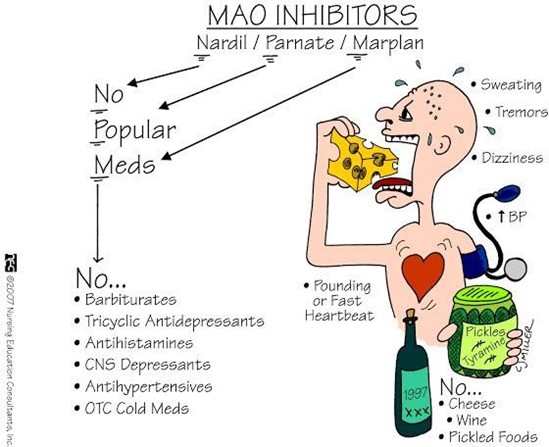A nurse is collecting data from a client who is taking tranylcypromine and reports ingestion of tyramine-rich foods.
The nurse should monitor the client for which of the following findings as an adverse effect of this medication?
Hyperglycemia
Hypertension
Hematuria,
Tinnitus
The Correct Answer is B
Explanation
B.Hypertension
Tranylcypromine is a monoamine oxidase inhibitor (MAOI) used to treat depression. One of the potential adverse effects of MAOIs is hypertensive crisis, which can be triggered by the consumption of foods high in tyramine. Tyramine-rich foods, such as aged cheeses, cured meats, certain wines, and fermented products, can cause the release of norepinephrine, leading to a sudden increase in blood pressure.
Monitoring the client for hypertension is crucial because a hypertensive crisis can be life-threatening. Signs and symptoms of hypertensive crisis may include severe headache, chest pain, palpitations, blurred vision, anxiety, and shortness of breath. If these symptoms occur, immediate medical intervention is required.
The other options are not specifically associated with the adverse effects of tranylcypromine:
Hyperglycemia in (option A) is not typically associated with tranylcypromine. However, it is important to monitor blood glucose levels in clients with pre-existing diabetes, as tranylcypromine can affect blood sugar control.
Hematuria (blood in the urine) in (option C) is not a common adverse effect of tranylcypromine.
Tinnitus (ringing in the ears) in (option D) is not a commonly reported adverse effect of tranylcypromine.

Nursing Test Bank
Naxlex Comprehensive Predictor Exams
Related Questions
Correct Answer is A
Explanation
Chemotherapy treatments, which are used to treat cancer, can suppress the immune system and weaken the body's ability to respond to vaccines. As a result, receiving a live attenuated vaccine like the varicella immunization can pose a risk of severe complications for individuals undergoing chemotherapy. Therefore, it is contraindicated to administer the varicella vaccine in this case.
Medications for a cardiac anomaly, clear rhinorrhea, and two diarrhea stools in the last day are not contraindications for receiving a varicella immunization.
While medications for a cardiac anomaly and certain medical conditions may require special consideration or precautions when administering vaccines, they are not absolute contraindications for the varicella vaccine. The decision to administer the vaccine would depend on the individual's specific circumstances and the healthcare provider's assessment. Clear rhinorrhea (runny nose) and two diarrhea stools in the last day are considered minor illnesses and do not contraindicate the varicella vaccine. Generally, mild illnesses without fever or systemic symptoms do not pose a significant risk when receiving vaccines. However, it is always important to assess the overall health status of the individual and consult with a healthcare provider if there are concerns.
Correct Answer is ["C","D","E","F"]
Explanation
Case management can be beneficial in situations involving assault to help coordinate and provide ongoing support and resources for the client. This intervention is appropriate in this scenario.
Ensuring a safe and private environment is crucial to protect the client's confidentiality and provide a supportive atmosphere during this difficult time. This intervention is necessary. Since the client reports being assaulted and has sore genitals, it is important to consider the risk of sexually transmitted infections (STIs). Administering STI prophylaxis can help prevent potential infections.
The client may benefit from additional support services such as counseling or support groups. Providing resources for local support services can help the client access the necessary help and support they need.
Contacting children and youth services is not applicable in this scenario as the client is a full-time college student and not a child or youth.
While the client mentioned drinking, it is not explicitly stated that they have an alcohol addiction or problem. Therefore, providing resources for Alcoholics Anonymous may not be the most appropriate intervention at this time.
Whether you are a student looking to ace your exams or a practicing nurse seeking to enhance your expertise , our nursing education contents will empower you with the confidence and competence to make a difference in the lives of patients and become a respected leader in the healthcare field.
Visit Naxlex, invest in your future and unlock endless possibilities with our unparalleled nursing education contents today
Report Wrong Answer on the Current Question
Do you disagree with the answer? If yes, what is your expected answer? Explain.
Kindly be descriptive with the issue you are facing.
